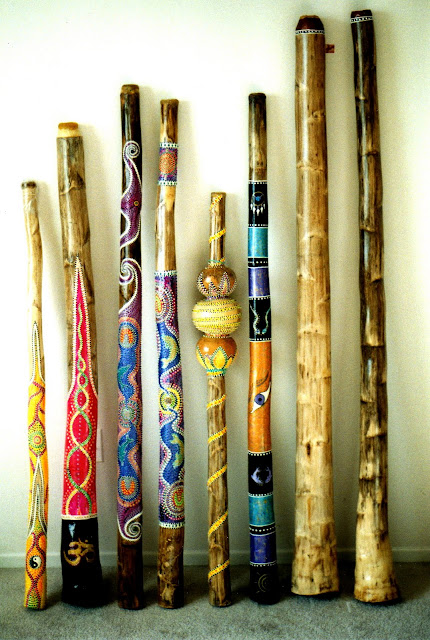Ivan and his Didgeridoo
The next morning I saw Ivan sitting on a big rock in the corner of the yard and I got the distinct impression that he did not want to be disturbed. He had his eyes closed and was meditating. I tip toed not to make a noise and then suddenly a deep and haunting sound came from the pipe. It was a musical instrument! The sound lasted for a very long time and I stood there frozen, listening and admiring it.
Later after breakfast I asked him what the name was and where it came from. It is called a Didgeridoo. I have never heard the word before and didn´t even know how to spell it! Luckily I was not the only one!
So what is a Didgeridoo?
The Didgeridoo is believed to be the worlds oldest wind instrument. It dates back thousands of years and originated as a musical instrument of the North Australian Aborigine. Ivan however did not get his instrument from Australia but from Indonesia.
Traditionally it is made from one of many species of Eucalyptus branches or saplings. Even though there are hundreds of species, only about 12 are used for Didgeridoo making. The Eucalyptus is naturally hollowed out by millions of termites. It takes at least a year for the termites to hollow a tree out. Harvesting has to be timed so that the wall thickness of the instrument is not too thin or not too thick. It has to be “just right”. Making for the perfect instrument!
The thickness and shape will determine which key the instrument will be in. Shorter lengths have higher pitches and longer lengths have lower pitches. Didgeridoos generally range in keys from a high “G” to a low “A”. A common “C” didgeridoo will be two steps below middle “C” of a piano. The keys of C and D are the easiest keys to learn how to play on the didgeridoo.
The bark is stripped from the outside and the termites removed and a rim of beeswax applied to reduce the diameter of the large opening. Wax also creates a good airtight seal for the mouth and makes it more comfortable to play. The instrument is now ready to be decorated with ochre paintings that symbolize a tribes food and/or totems.
Before Ivan,Jose and Javier left we asked him to pose for a couple of photos. He took positioning on the rock and started to play. It is not an easy instrument to play.You blow down the tube with loose lips creating a vibration that echoes down the tube coming out amplified as a drone.It is very important to stay relaxed because if you try too hard it will tighten your muscles which contradicts the need to create loose lips. Buzz your lips while gently pushing air down the tube.
We stood there for a little while admiring the sound that came from this tube. The wind was rustling through the leaves and the birds were flying in the sky. It was a beautiful autumn morning and the sounds made it even more beautiful.
Jose told me that he bought the instrument as a gift for Ivan in Indonesia. He owned a small furniture company and imported from Indonesia. Time stood still for a little while but then they had to get ready for the long road back to Buenos Aires.
| Ivan, Jose and Javier. |
When I look at that rock in the corner of the garden I will remember Ivan and his Didgeridoo.
Here is a video clip of Ivan playing the Didgeridoo.











